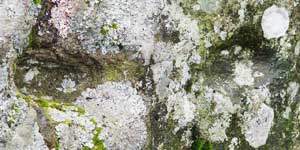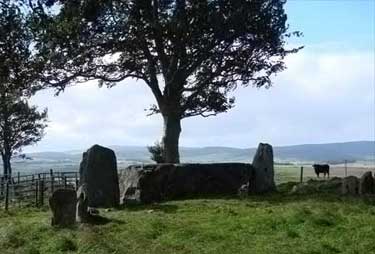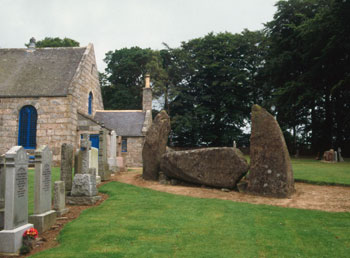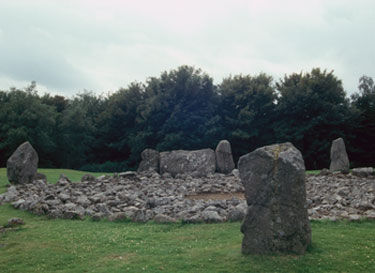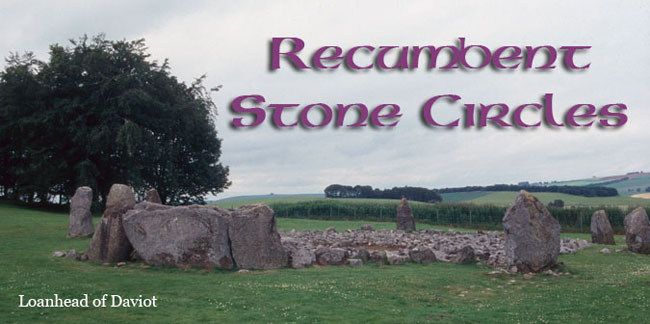
Introduction
Recumbent Stone Circles (RSC's) are found in the Grampian region of northeast Scotland where over one hundred have been identified. They are particularly concentrated in the rolling hills around Bennachie, a singular peak dominating the Aberdeenshire countryside. These are the best and earliest examples of the type, dating (on the basis of the pottery) to about 3000 BC. Over the course of the following centuries, the tradition spread to some of the peripheral areas to the north, east and south—the latest dating to about 1500 BC. This probably represents a spread of settlement to less favourable parts of the region as population steadily increased throughout the Bronze Age.
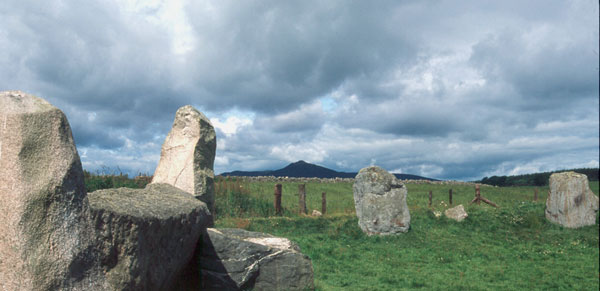
Bennachie from East Aquhorthies
The circles are smallish—perhaps 18-25 metres in diameter—and are usually made up of ten or eleven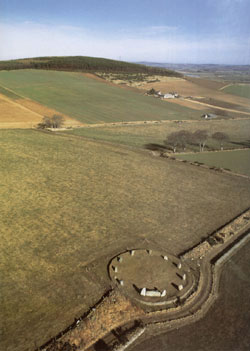 stones, graded in height, with the tallest pair set in the south-western quadrant flanking a much larger stone lying on its side (the recumbent). The recumbents and their flankers were carefully chosen and are generally of a different composition and colour to the rest. At Easter Aquhorthies, a few miles west of Inverurie, most of the stones are of pinkish porphyry but one is red jasper. They contrast with the light grey of the granite flankers and the red granite recumbent. Cupmarks (below right)—small, roughly circular depressions—had been carved into the surface of many of the stones, including the recumbent as well as several of the neighbouring uprights. The purpose of these marks is unknown although some suspect that the stones bearing them may have been used as astronomical sight lines.
stones, graded in height, with the tallest pair set in the south-western quadrant flanking a much larger stone lying on its side (the recumbent). The recumbents and their flankers were carefully chosen and are generally of a different composition and colour to the rest. At Easter Aquhorthies, a few miles west of Inverurie, most of the stones are of pinkish porphyry but one is red jasper. They contrast with the light grey of the granite flankers and the red granite recumbent. Cupmarks (below right)—small, roughly circular depressions—had been carved into the surface of many of the stones, including the recumbent as well as several of the neighbouring uprights. The purpose of these marks is unknown although some suspect that the stones bearing them may have been used as astronomical sight lines.
Sites tended to be close to suitable farmland, often on the shoulder of a hill with a good view of the southern horizon. Another important consideration was the availability of good stone. While only a small number of workers—perhaps less than a dozen—would have been required to transport and set up most of the stones in the circle, the recumbents tend to be much larger and heavier. The one at Old Keig weighs over 50 tonnes and came from a source over 10 kilometres away. Dragging such an enormous block to the site would have needed the effort of at least a hundred people.
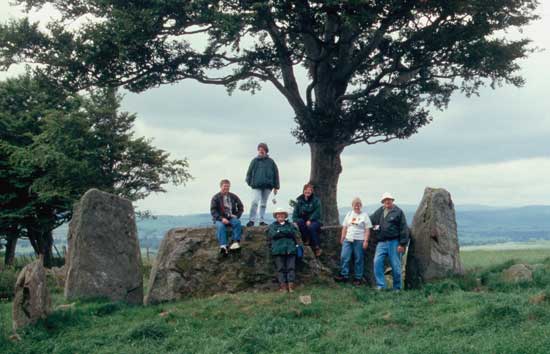
Old Keig
Aubrey Burl believes the use of recumbents can be traced back to Ireland where similar stones can be found at the entrances to passage graves (Knowth and Newgrange for example). Irish pottery and stone axes (Group IX) have been found in the region, so there must have been some sort of contact. According to Burl,
…an RSC can be seen as a combination of traditions, that of the plain stone circle coming together with the intermixing of settlers, traders and incomers in the first centuries of the third millennium.
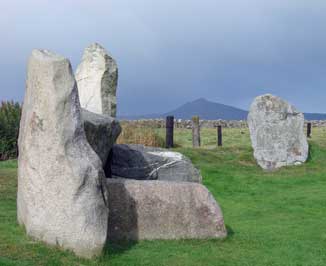 A few of the recumbents, such as the one at Easter Aquhorthies (right), have what appear to be vestigial passages— defined by long slabs of stone—running inwards, towards the centre of the circle. They do seem a little short, however.
A few of the recumbents, such as the one at Easter Aquhorthies (right), have what appear to be vestigial passages— defined by long slabs of stone—running inwards, towards the centre of the circle. They do seem a little short, however.
Unfortunately, most of the sites have been destroyed or were very badly damaged in the nineteenth century-through agricultural activities or religious zealotry. Many of the circles in the hills around Bennachie, however, are reasonably well-preserved and a number of them have been excavated to some extent.
It looks as though the three major stones were laid out first and then the circle was attached—at least that is what the somewhat eccentric relationship between the two elements at some of the sites suggests. At Loanhead of Daviot, for example, the recumbent and flankers are laid out tangential to what is otherwise a perfect circle. Apparently it was important that the upper side of the recumbent was horizontal and parallel to the ground. To this end, the stone was actually tapered so that it might be levered into the correct position more easily.
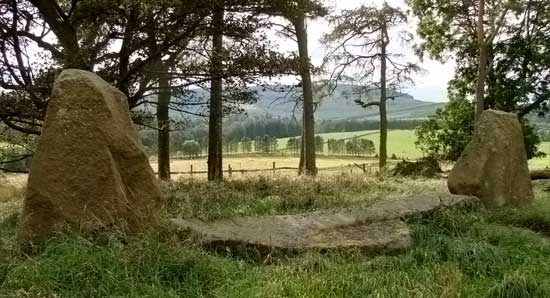
Sunhoney. Recumbent Stone Circle
At many of the sites, the upper surface of the recumbent is actually more of an edge—too narrow to support an outstretched body or sacrificial animal—and therefore not really suitable as an altar although it is tempting to imagine it as such. The setting is far too broad to have been much use for sighting solar events or the appearance of particular stars. The most convincing alignment involves the lunar cycle of 18.61 years and the majority of recumbents lie on the arc between the major rising and setting of the moon at these latitudes—roughly south-southeast to southwest.
A number of the circles contained cremated bone, pottery, ash and charcoal. Evidently, some sort of large wooden structure had been built, either inside or just outside the ring. A body was laid out, more wood was heaped on top of it and the whole thing was set alight—there are extensive areas of burned earth at Loanhead of Daviot and Old Keig. Once the fire had died down, it would seem that the area was scraped clean and some of the material was collected and buried. The ritual strongly suggests dedicatory ceremonies rather than funeral rites.
The sites were used as ceremonial centres for communal activities associated with the land and fertility. The rhythms of the moon, so closely identified with the fertility cycle in women, would have been an obvious focus of attention. As was the case with other circles, the RSC's would have 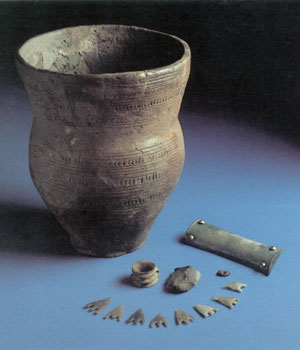 also been the scene of other, social and economic, activities as well. However, all of this would change at the beginning of the Bronze Age.
also been the scene of other, social and economic, activities as well. However, all of this would change at the beginning of the Bronze Age.
Ring Cairns, very low circles of cobbles bounded by kerbstones, were later built into many of the circles, covering the ashy layer. A circular area was left uncovered in the centre of the cairn and cremated bone was placed in the space, often in a pit. Associated small finds suggest that all of this secondary activity took place during the Beaker Period, several centuries after the first RSC's were built. Beakers are associated with the appearance of the earliest metalwork in Scotland and the emergence of a new elite. It has been suggested that Beaker equipment— not just the drinking vessels themselves, but metal daggers, flint arrowheads, archer's wrist guards, and gold jewellery—were all part of a cult package which solidified social relationships among the new aristocracy. The photo to the left shows a typical Beaker grave assemblage from Culduthel near Inverness. The usurpation of previous monuments was a common occurrence wherever beakers appeared. As the picture of Midmar Kirk (right) shows, this would not be the last time this sort of thing happened.
Circles continued to be built in the remoter hills and valleys in the Grampians where the old ways were still followed, but they were increasingly debased examples of the type. After about 1500 BC, there were no new ones.
Loanhead of Daviot
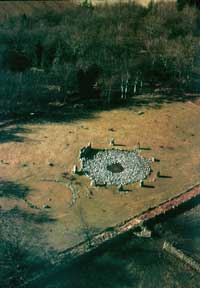 The circle at Loanhead is just under twenty metres in diameter and sits on a levelled terrace near the top of a gentle hillside 8 kilometres northwest of Inverurie In addition to the recumbent, there were ten upright stones, several of which had small cairns of stone at the base. The cairns covered pits which were found to contain charcoal and beaker pottery-one contained an urn with cremated bone inside. One of the stones—the one next to the eastern flanker—has 5 cupmarks and may have marked the
The circle at Loanhead is just under twenty metres in diameter and sits on a levelled terrace near the top of a gentle hillside 8 kilometres northwest of Inverurie In addition to the recumbent, there were ten upright stones, several of which had small cairns of stone at the base. The cairns covered pits which were found to contain charcoal and beaker pottery-one contained an urn with cremated bone inside. One of the stones—the one next to the eastern flanker—has 5 cupmarks and may have marked the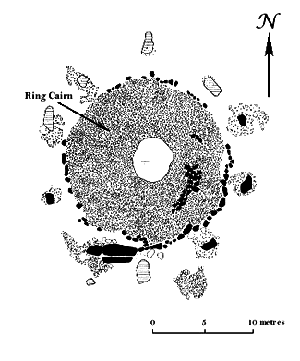 midwinter sunrise as viewed from the centre of the circle. The recumbent itself is in the south-western quarter and sits somewhat askew to the rest of the circle. The twelve tonne stone has been split lengthwise by centuries of frost action.
midwinter sunrise as viewed from the centre of the circle. The recumbent itself is in the south-western quarter and sits somewhat askew to the rest of the circle. The twelve tonne stone has been split lengthwise by centuries of frost action.
The interior of the circle was covered by a layer of black earth and charcoal some 5 cm. thick. Underneath it, the excavators found what appear to be four postholes, possibly for a mortuary house (1.2 x 0.6 metres). It looks as though the structure was burned and the ashes carefully spread around. There is no evidence of cremation although the bones may well have been taken away after the event.
With the beginning of the Bronze Age, a ring cairn was built over top of the ashy layer, taking up much of the interior apart from a circular space roughly in the middle and a reserved area behind the recumbent and flankers. The cremated remains of about fifty individuals, adults and children, were uncovered in the central space
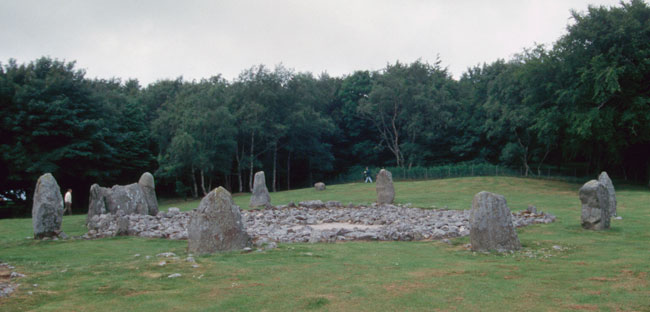
Recumbent Stone Circle at Loanhead of Daviot


